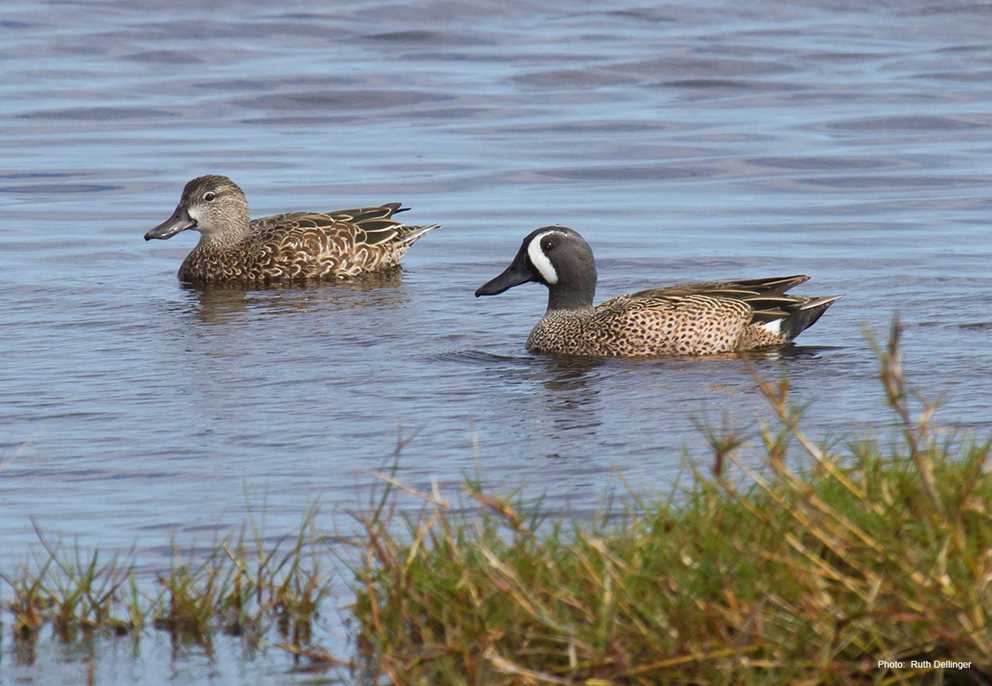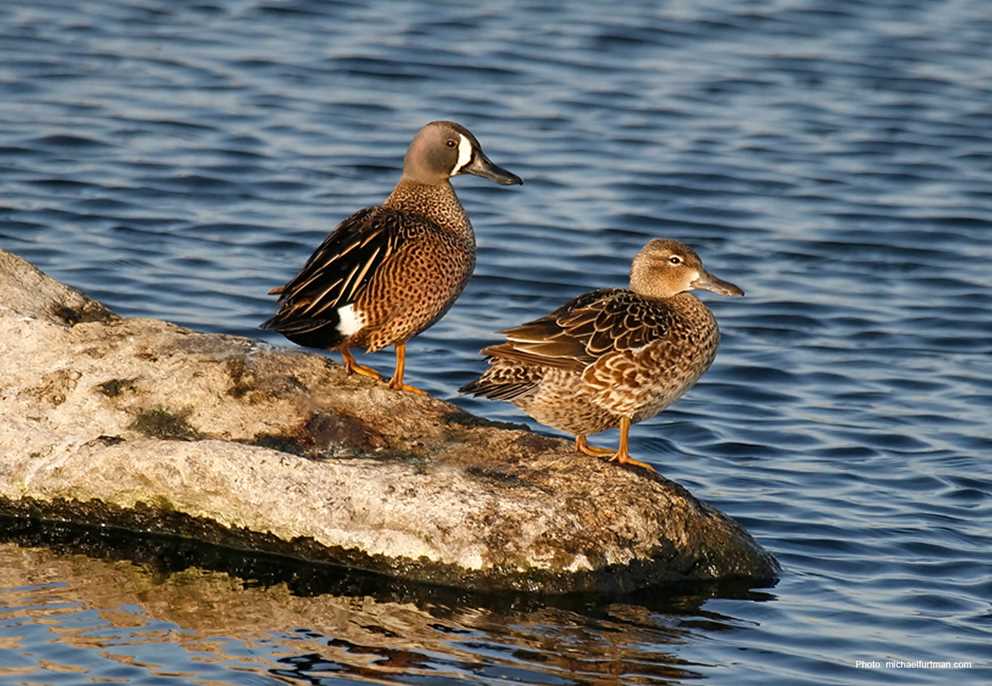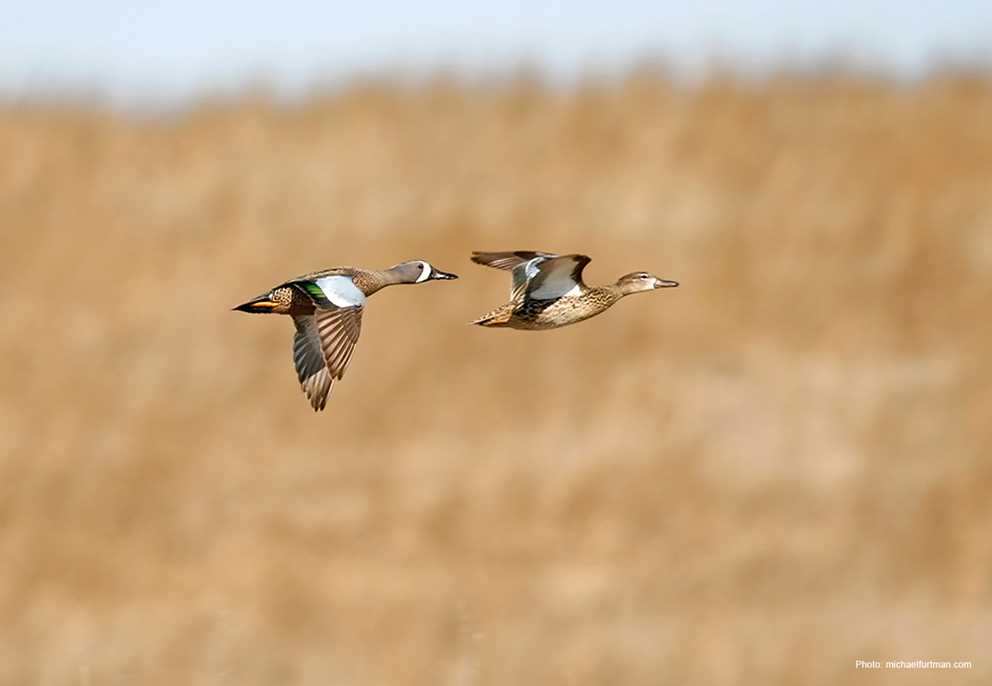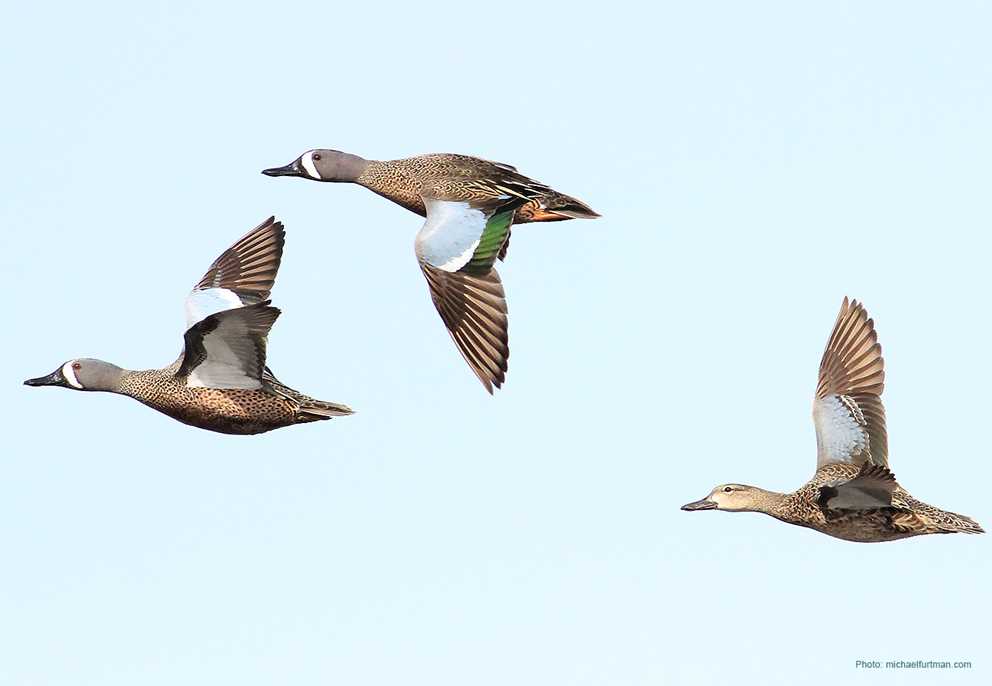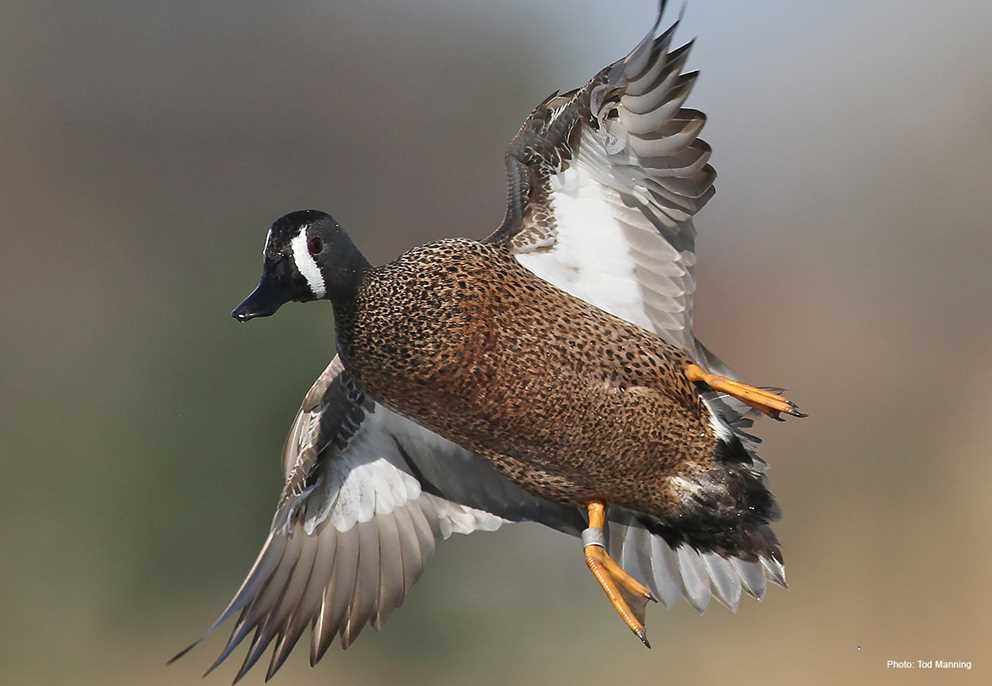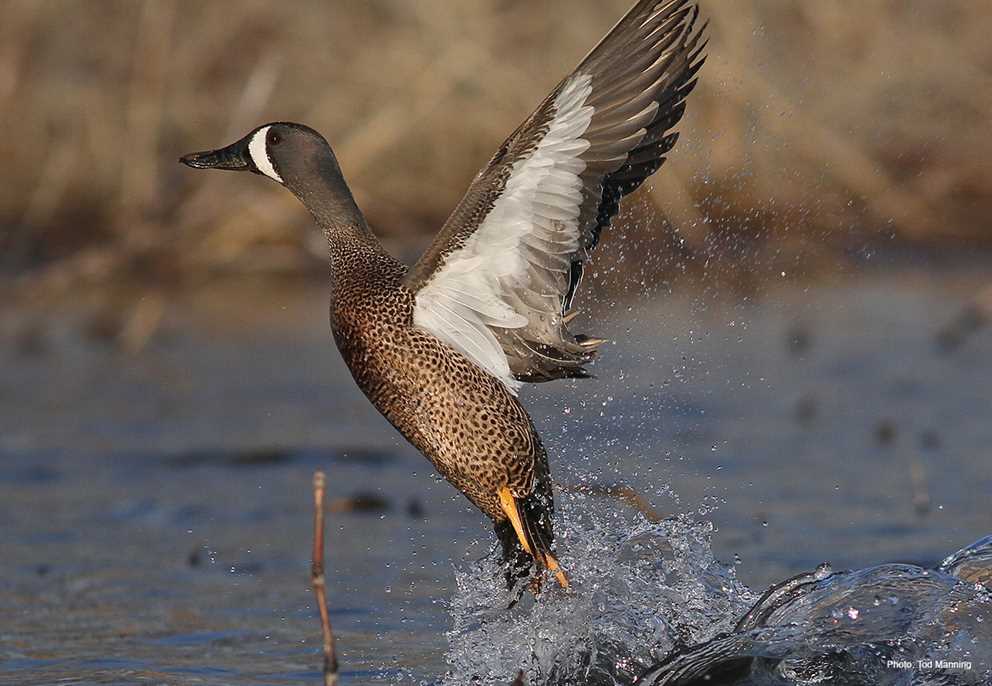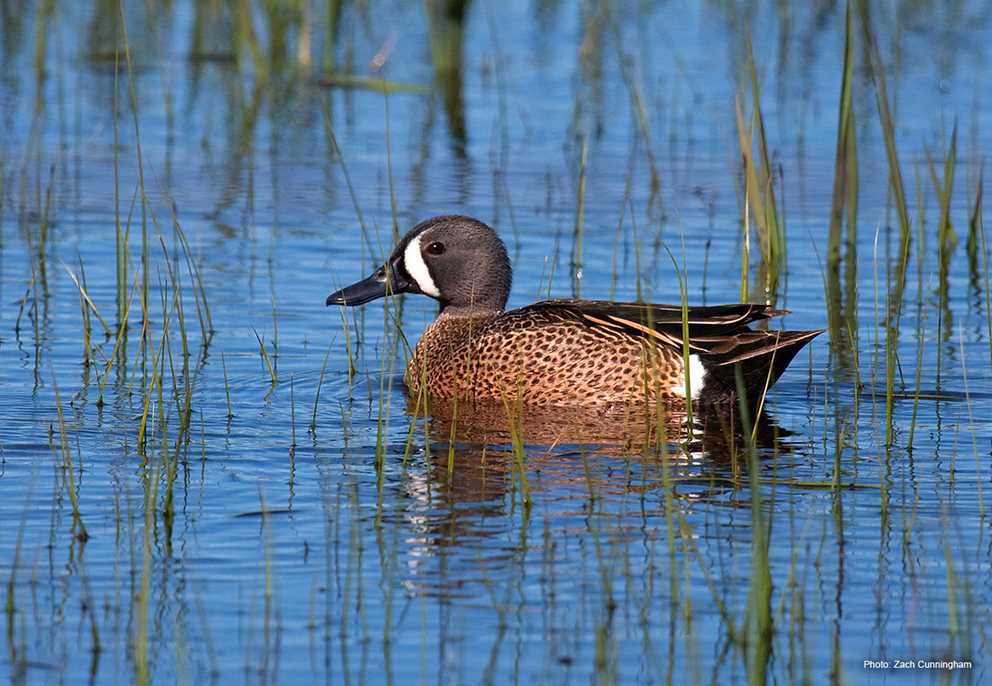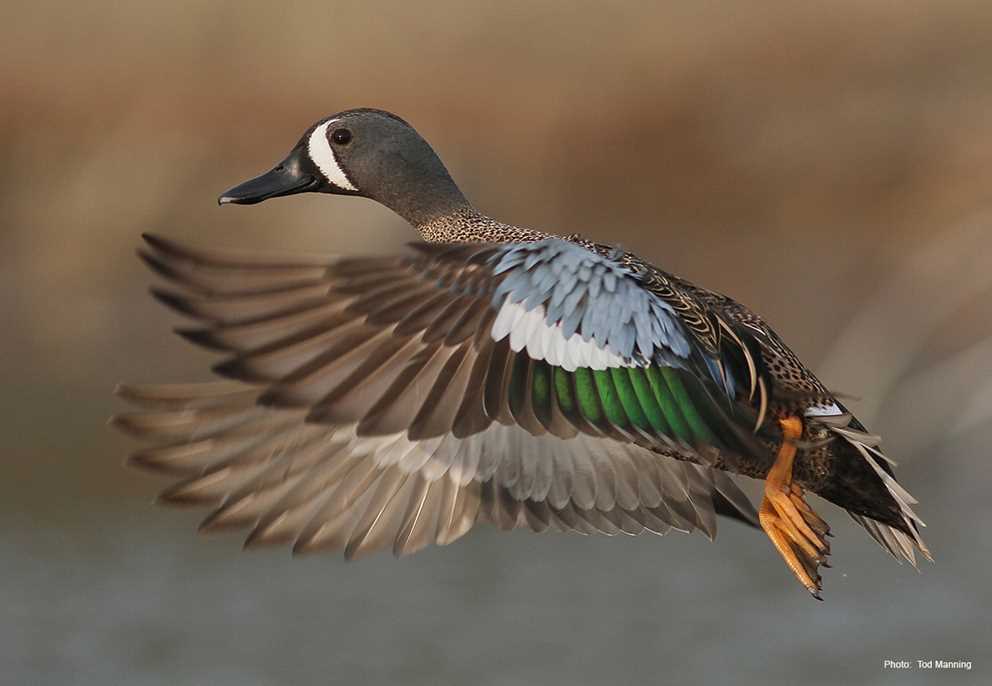Overview
The Blue-winged Teal is a small dabbling duck whose breeding range is restricted to North America from eastern Alaska south across Canada to Newfoundland and Labrador. The core of their breeding range is in the Prairie Pothole Region of Canada and the United States. In the United States, the breeding range includes the Intermountain West, Great Plains, and Upper Midwest. A small number of Blue-winged Teal also breed in coastal Louisiana and Texas. Blue-winged Teal predominantly use freshwater wetlands throughout their range, though in coastal areas they will also use brackish wetlands.
Male and female Blue-winged Teal are named for the powder blue wing patch on their upper wing. Males in alternate plumage have a dark blue-gray head with a distinct white crescent in front of the eye to the base of the bill. Their contour plumage is cinnamon -buff with dense dark spots throughout. The blue patch on the wing is brighter than in females, and the speculum is iridescent green. A notable white patch is present on the rear flank.
Description
Key Identification Features
- Males have a distinct white crescent in front of the eye to the base of the bill. Their contour plumage is cinnamon buff with dense dark spots throughout and the speculum is iridescent green. A notable white patch is present on the rear flank. The bill is black, and the legs and feet are yellow-orange.
- Females are mottled brown overall and have a somewhat duller blue patch on the wing, the anterior border of the speculum has brown edging on the white secondary coverts, and the speculum is blackish brown with green iridescence.
Male/Female Average Length and Weight
- Weight: Males 0.8–1.0 lbs.; Females 0.7–1.1.
- Wingspan: Males 7.1 in.; females 6.9 in.
Male Identification
- Alternate (Breeding) Plumage: Male and female Blue-winged Teal are named for the chalky blue wing patch on their upper wing. Males in alternate plumage have a dark blue-gray head with a distinct white crescent in front of the eye to the base of the bill that extends from above the eye to the lower cheek. Their contour plumage is cinnamon-buff with dense dark spots throughout. The blue patch on the wing is brighter than in females, and the speculum is iridescent green with a bold white anterior border. A notable white patch is present on the rear flank. The rump and vent area are black, and the tail is gray brown. The bill is black, and the legs and feet are yellow orange. Hunters often encounter males in early teal seasons that are in basic plumage or beginning the pre-alternate molt. The wing is the most useful tool to separate males and females, though many males will have a faint white crescent on the face.
- Basic Plumage: Overall mottled brown, sexes somewhat similar, males will have a somewhat lighter and grayer head, and may show a faint gray to white crescent.
Female Identification
- Alternate and Basic Plumage: Females are mottled brown overall, often show a lighter white or grayish patch at the base of the bill, and have a dark eye stripe. The bill is grayish and has variable small dark spots. The wing of the female has a somewhat duller blue patch, the anterior border of the speculum contains brown feathers with variable in white edges, the speculum is blackish-brown with hints of green iridescence, and grayish yellow legs and feet.
In-flight Identification
- In flight, the powder blue wing patch is distinctive.
Vocalizations
- Males make a single high pitch whistled “peew” and a decrescendo of the same sound accented on the first whistle.
- Females make a “quack” or a short series of decrescendo “quacks” similar to, but higher pitched than Mallards.
Similar Species
- In flight, the powder blue wing patch is distinctive, but also present on Cinnamon Teals and Northern Shovelers. Males in alternate plumage are easily distinguished. In basic plumage, separation is challenging but Cinnamon Teal have subtle differences including showing more warm-brown contour plumage, less patterned flanks, and a slightly longer and more spatulate bill. Separate from Northern Shovelers in basic plumage is based on bill shape, wing length, and overall size. Immature male and all female Northern Shovelers typically show orange in the bill.
Habitat Preferences
- Breeding: Blue-winged Teal prefer shallow freshwater wetlands with abundant invertebrates which comprise the bulk of their diet during the breeding season. Nests in upland grass or herbaceous vegetation in landscapes with lots of wetlands.
- Migration and Winter: Habitat is usually fresh to intermediate salinity shallow emergent wetlands with abundant seeds and invertebrates for food.
Foraging Habits and Diet
- Blue-winged Teal diet varies across seasons and habitats. For breeding birds their diet is less than 90 percent invertebrates including aquatic insects, crustaceans, and clams. During spring migration, the diet is 35 percent seeds of moist soil plants, and 65 percent invertebrates. In fall and winter, the diet is variable and opportunistic and includes a variety of seeds and invertebrates. Feeds in flooded harvested rice fields where they occur within their range.
Breeding Habits
- Monogamy: Blue-winged Teals are seasonally monogamous. They pair in wintering areas or during spring migration. Blue-winged Teal are mid to late spring migrants and arrive in breeding areas usually from April to May, and nest from late April to May.
- Nest Location: They are somewhat nomadic and often settle in areas of higher wetland density that varies from year to year. They prefer grassland or herbaceous upland sites for nesting.
- Clutch Size: Averages 8 to 12 eggs. The eggs are cream colored, sub-elliptical, and are 1.9–1.3 in. The incubation period is approximately 24 days. Renesting has been documented when the nest is lost during laying or early incubation, but frequency tends to be relatively low (30 to 40 percent) given their later arrival and nest initiation dates.
Migration & Distribution
- Fall Migration: Blue-winged Teals are late summer to early fall migrants, often departing breeding areas in August or early September. They arrive in wintering areas as early as early September.
- Spring Migration: They are mid-spring migrants, departing winter areas in the latter half of March or in April, and arrive at their breeding areas in late April to early May.
Conservation Status
- IUCN Status: Least Concern
- Population Status: The USFWS Waterfowl Population Status, 2024, estimated a breeding population of 4.6 million Blue-winged Teal, with the long-term average breeding population of 5.1 million birds.
- Conservation Concerns: Loss of wetlands due to agricultural conversion primarily in the Prairie Pothole region are negatively impacting Blue-winged Teal populations.
- Conservation Status: Protection and restoration of wetlands is the primary approach to conserve Blue-winged Teal populations. More research is required to understand the possible challenges in their wintering range in Central and South America.
Harvest Information
- An average of 865,390 Blue-winged Teal were harvested per season across the US during the 2019–2022 hunting seasons.
- Blue-winged Teal harvest is highest in the Mississippi Flyway accounting for 50 to 60 percent of the total US harvest.
- The top three harvest states for Blue-winged Teal across the 2019–2022 hunting seasons were Texas (864,442), Louisiana (768,460), and Minnesota (363,703).
